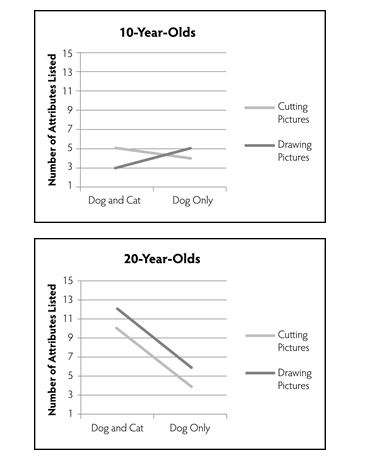RESEARCH STUDY 11.2
(The first paragraph is repeated from earlier. The second paragraph is specific to the new set of questions. The first paragraph is necessary to set up the original study.)
Dr. Elder was interested in the way people recognize objects as members of categories. For example, what makes us recognize a dog as being a dog and not a cat? More specifically, he was curious as to whether people think about categories in a more complex way if they contemplate an "opposite" category first. For example, does a person think more differently about the category of "southern" if they are also thinking about the category of "northern"? He is also curious as to whether people categorize differently if they are exposed to category members compared with generating category members. Dr. Elder has four groups of participants (with 30 people in each group). In Group A, participants were told to cut out pictures of dogs and cats from magazines. In Group B, participants were told to cut out pictures of just dogs from magazines. In Group C, participants were told to draw pictures of cats and dogs. In Group D, participants were told to draw pictures of just dogs. After doing this for 30 minutes, participants in all groups were asked to list the attributes that define the "dog" category. Having a higher number of attributes listed was considered to be an indication of thinking about the category in a more complex way.
Dr. Elder also is curious as to whether categorization happens similarly for children as it does for adults. As such, he recruits a group of 10-year-olds and a group of 20-year-olds to participate in the study. The results are below.

-Refer to Research Study 11.3 above to answer the following question.
Using the marginal means,state whether it appears that the main effects in Dr.Lopez's study are important.(You do not need to say whether the main effects are statistically significant,but simply whether a difference appears to exist.)
Definitions:
Environment
The surrounding conditions, influences, or forces which affect the life, behavior, and development of individuals or populations.
Wellness
A holistic state of well-being encompassing physical, mental, and social health, not merely the absence of disease or infirmity.
Nursing
A healthcare profession focused on the care of individuals, families, and communities so they may attain, maintain, or recover optimal health and quality of life.
Community Variables
Factors that influence the characteristics, behaviors, health, and well-being of members within a community.
Q2: When examining an association claim using a
Q10: The most populous Brazilian State is _.<br>A)
Q21: Effects of glaciation would be LEAST prevalent
Q27: According to the text,when researchers conduct longitudinal
Q37: The Caribbean Coast of Middle America is
Q37: You and your friends go to see
Q38: Which of the following States contains territory
Q47: The leading agricultural activity of the Pampa
Q81: Relative location has far less relevance in
Q95: The Incas were true colonizers who contributed